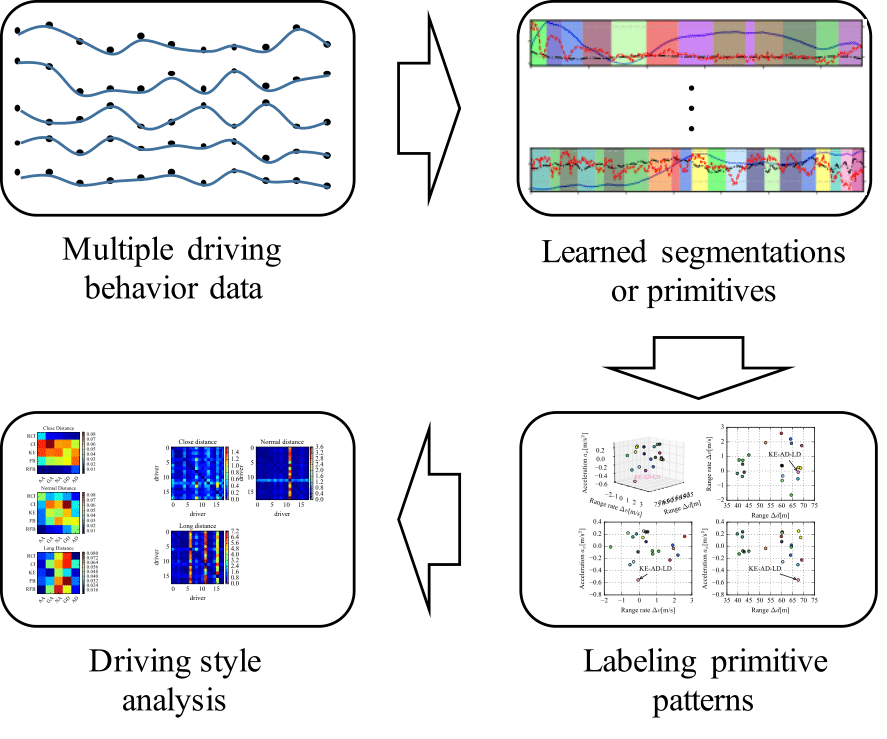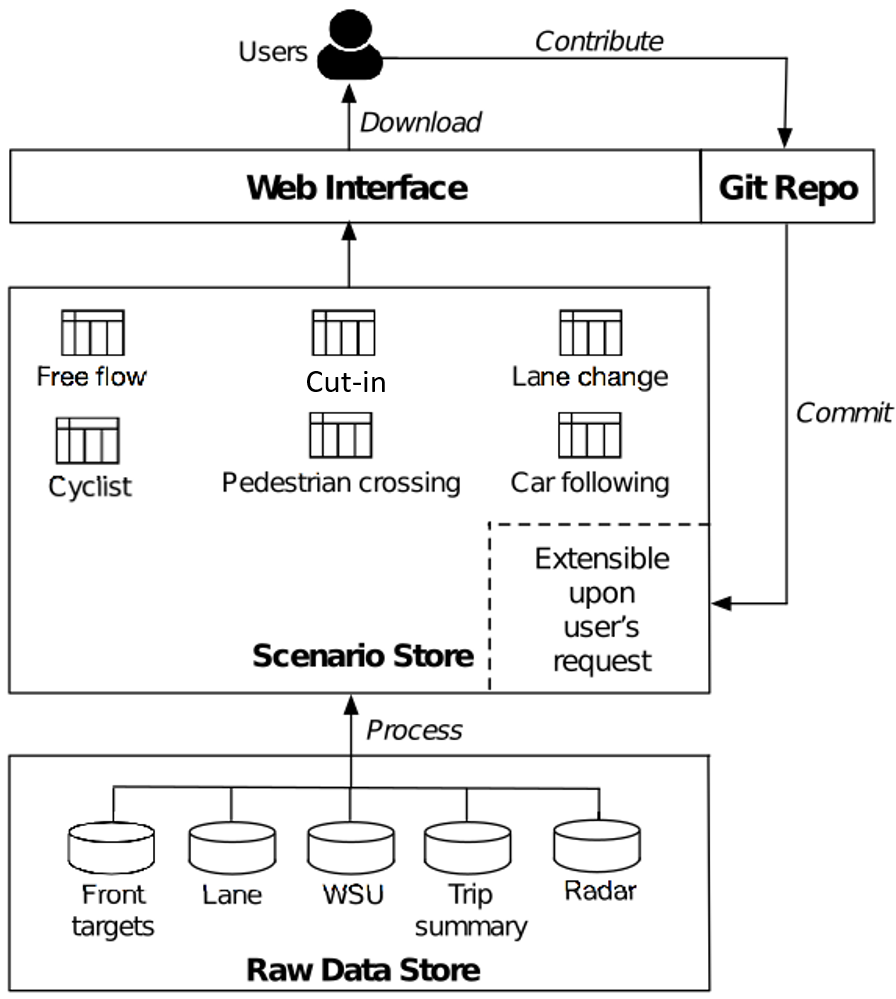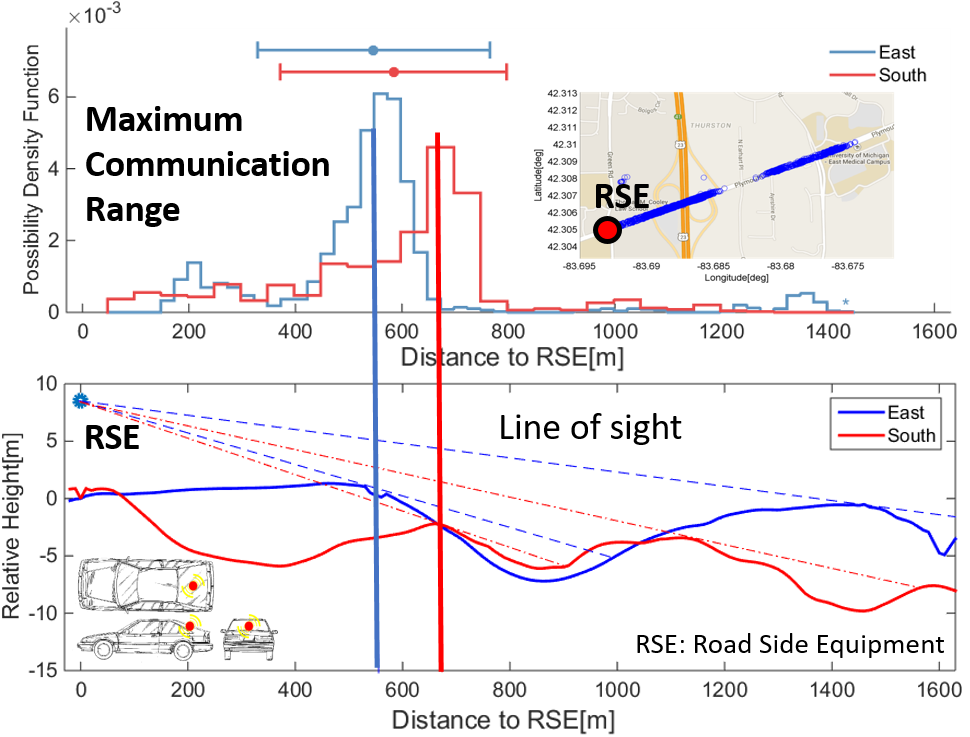Learn the Driving Environment

Traffic Primitives: Extract Fundamentional Traffic Elements using Bayesian Unsupervised Learning
 Wenshuo Wang, Ding Zhao, ''Extracting Traffic Primitives Directly from Naturalistically Logged Data for Self-Driving Applications,'' IEEE IEEE Robotics and Automation Letters, 2017.
|
Wenshuo Wang, Ding Zhao, ''Extracting Traffic Primitives Directly from Naturalistically Logged Data for Self-Driving Applications,'' IEEE IEEE Robotics and Automation Letters, 2017.
|
Wenshuo Wang, Junqiang Xi, Ding Zhao, ''Driving Style Analysis Using Primitive Driving Patterns With Bayesian Nonparametric Approaches,''IEEE Transactions on Intelligent Transportation Systems, 2017.
|
Abstract — Developing an automated vehicle, that can handle the complicated driving scenarios and appropriately interact with other road users, requires the ability to semantically learn and understand the driving environment, oftentimes,
based on the analysis of massive amount of naturalistic driving data. An important paradigm that allows automated vehicles to both learn from human drivers and develop deeper insights is understanding traffic primitives, representing principal compositions
of the entire traffic. However, the exploding driving data growth presents a great challenge in extracting primitives from a long-term multidimensional time-series traffic scenario data with multiscale varieties of road users get involved. Therefore,
automatic primitive extraction is becoming one of the cost-efficient ways to help autonomous vehicles understand and predict the complex traffic scenarios. In addition, the extracted primitives from raw data should 1) be appropriate for automated
driving applications and also 2) be easily combined to generate new driving scenarios. Existing literature does not provide a method to automatically learn these primitives from large-scale traffic data. The contribution of this paper has two manifolds.
One is that we proposed a new framework to generate new traffic scenarios from a handful of limited traffic data. The other one is that we introduce a nonparametric Bayesian learning method - a sticky hierarchical Dirichlet process hidden Markov
model - that can automatically extract primitives from multidimensional driving data without prior knowledge of the primitive settings. The developed method is validated using one day of naturalistic driving data. Experiment results show that the
nonparametric Bayesian learning method extracts primitives from traffic scenarios where both the binary and continuous events coexist.
TrafficNet: An Open Naturalistic Driving Scenario Library
 Ding Zhao, Yaohui Guo, Yunhan Jack Jia, ''TrafficNet: An Open Naturalistic Driving Scenario Library, '' Proceedings of the IEEE 20th International Intelligent Transportation Systems Conference (ITSC), Yokohama, Japan, October
16-19, 2017.
|
Ding Zhao, Yaohui Guo, Yunhan Jack Jia, ''TrafficNet: An Open Naturalistic Driving Scenario Library, '' Proceedings of the IEEE 20th International Intelligent Transportation Systems Conference (ITSC), Yokohama, Japan, October
16-19, 2017.
|
Abstract — The enormous efforts spent on collecting naturalistic driving data in the recent years has resulted in an expansion of publicly available traffic datasets, which has the potential to assist the development of the self-driving
vehicles. However, we found that many of the attempts to utilize these datasets have failed in practice due to a lack of usability concern from the organizations that host these collected data. For example, extracting data associated with certain
critical conditions from naturalistic driving data organized in chronological order may not be convenient for a vehicle engineer that doesn't have big data analytics experiences. To address the general usability challenges of these publicly available
traffic datasets, we propose TrafficNet, a large-scale and extensible library of naturalistic driving scenarios, aiming at bridging the gap between research datasets and practically usable information for vehicle engineers and researchers. The proposed
web-based driving scenario database preprocesses massive raw traffic data collected in chronological order into an organized scenario-based dataset by applying a set of categorization algorithms to label the naturalistic driving data with six different
critical driving scenarios. TrafficNet opens not only the scenario library but also the source code of these categorization methods to the public, which will foster more sophisticated and accurate scenario-based categorization algorithms to advance
the intelligent transportation research. The source code and the scenario database can be accessed at https://github.com/TrafficNet.
Evaluation of Connected Vehicle Communication with Three-year Real World Data
 Xianan Huang, Ding Zhao, Huei Peng, ''Empirical Study of DSRC Performance Based on Safety Pilot Model Deployment Data,''
IEEE Transactions on Intelligent Transportation Systems, 2017.
|
Xianan Huang, Ding Zhao, Huei Peng, ''Empirical Study of DSRC Performance Based on Safety Pilot Model Deployment Data,''
IEEE Transactions on Intelligent Transportation Systems, 2017.
|
Abstract — Dedicated Short Range Communication (DSRC) was designed to provide reliable wireless communication for intelligent transportation system applications. Sharing information among cars and between cars and the infrastructure,
pedestrians, or "the cloud" has great potential to improve safety, mobility and fuel economy. DSRC is being considered by the US Department of Transportation to be required for ground vehicles. In the past, their performance has been assessed thoroughly
in the labs and limited field testing, but not on a large fleet. In this paper, we present the analysis of DSRC performance using data from the world's largest connected vehicle test program - Safety Pilot Model Deployment lead by the University
of Michigan. We first investigate their maximum and effective range, and then study the effect of environmental factors, such as trees/foliage, weather, buildings, vehicle travel direction, and road elevation. The results can be used to guide future
DSRC equipment placement and installation, and can be used to develop DSRC communication models for numerical simulations.